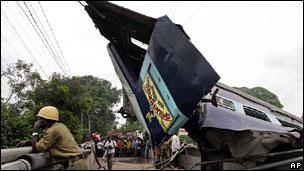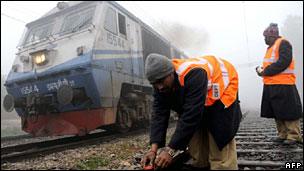India's patchy railway safety record
- Published

India's railway safety record is patchy
Indian Railways, a state-run behemoth with over 1.4 million employees, aims to eliminate accidents by 2020.
But Monday's crash in West Bengal state - where 60 people died when a passenger train ploughed into another - shows it will not be easy to meet this goal.
The world's fourth largest railway network - over 63,000km (40,000 miles) long, just behind the US, Russia and China - continues to have a patchy safety record: there have been more than 1,000 accidents since 2004 alone.
The number of crashes may have declined - 177 in 2008-09, down from 320 in 2003-04, and an alarming 2,000 in 1960-61- but safety remains a pressing issue.
More than 200 people died in railway accidents in 2008-09. So far this year about 200 people have already died in accidents, the majority in a collision caused by suspected sabotage of tracks by Maoist rebels.
This despite a special $3.6bn (£2.4bn) railway safety fund to make travelling safer for more than 6bn passengers who every year use the transport network known as India's lifeline.
The money has been set aside to repair decaying tracks, bridges, signalling gear and rolling stock, among other things.
'Cause for concern'
But an internal assessment by the railways admits that a substantial portion of the money remains unutilised - "a cause for concern".
Particularly worrisome, it says, is the "slow progress" of work on building railway bridges as well as upgrading and manning crossings across the country.

Indian railways carry some 6bn passengers every year
Unmanned railway crossings - there are nearly 17,000 - have been responsible for over a third of all railway accidents since 2004, and account for nearly 70% of the fatalities.
In some states, like West Bengal, they actually outnumber manned railway crossings.
Train collisions, such as the one on Monday, are also one of the main causes of accidents - there were 13 such crashes during 2008-09 and they led to a number of fatalities.
"Collisions remain a big danger and they are always caused by human failure, despite our fail-safe systems," says IIMS Rana, former chairman of the Indian Railway Board.
Railways officials say they have rolled out a locally made anti-collision device on more than 1,700km of tracks in north-eastern India. Improved devices are expected to roll out in the rest of the country.
But former railway officials like Mr Rana say that India still lags behind on anti-collision technologies, which are standard in the West.
They talk about a device which, once installed on a train, brings it to an automatic stop if it overshoots a red signal.
"We don't have such systems. Money is also a constraint," says Mr Rana.
Then there are accidents caused by trains coming off the tracks - there have been 550 since 2004. Derelict or ill-maintained tracks are to blame.
Sabotage
Sabotage of tracks is also becoming an alarming and relatively new cause of accidents - a lot of networks run through territory where India's Maoist rebels have a presence, and the insurgents have been known to remove track fish-plates.

Trains often come off the tracks
Sabotage, in fact, was responsible for 13 accidents in 2008-09, up from only four cases in 2004-05.
If you look at railway's internal safety records, human errors made by people "other than railway staff" are to blame for most accidents - 75 of the 177 accidents in 2008-2009 are attributed to such elements.
It is not even clear who these other people to blame for the accidents - they are perhaps those who are crossing unmanned crossings when they get hit by oncoming trains.
Analysts say the problem with Indian Railways is that it has been lagging behind despite the increase in revenues from improved passenger and freight growth.
For example, it has added a mere 220km of new track every year since 2004, compared with over 1,000km of new track by China's railways.
There is really no excuse, analysts say, for a "bloated" organisation like Indian Railways to renege on promises of ensuring a safe journey for passengers.
Clearly, it needs to move quickly and invest in upgrading tracks and signals, and importing state-of-the art technology to make journeys safer.